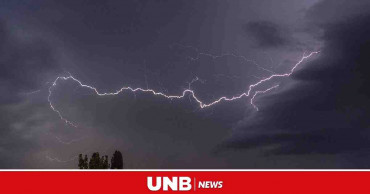Disaster Management and Relief
After playing down chances of Sitrang, Enamur now warns of December cyclone
Another cyclone is likely to hit Bangladesh in December, said Bangladesh State Minister for Disaster Management and Relief Md Enamur Rahman on Tuesday.
According to the information of Bangladesh Meteorological Department (BMD), another cyclone may hit the country in the month of December, he said while speaking at a press briefing over the cyclone Sitrang at the Secretariat.
“Prime Minister Sheikh Hasina thanked me over phone on Monday night for taking measures for Cyclone Sitrang and she also asked me that there will be another cyclone which may hit the country in December. She asked me to take precautionary measures like Sitrang,” said the minister.
Read:4 lakh coastal people took refuge at Ashrayan homes during Sitrang: PMO
The state minister said around 10,000 houses in 419 unions of the country were damaged by cyclone Sitrang that lashed the coastal districts Monday night.
Sitrang did not turn into a severe cyclone and crossed the coastal area very quickly, the state minister said while talking to reporters at the Secretariat regarding the aftermath of the cyclone.
“We have been able to provide shelter to 10 lakh people in 6,925 cyclone shelters. The cyclone weakened quickly after hitting the coastal districts at 10pm,” said Enamur.
People have already left the shelters, he added.
Read: Cyclone Sitrang aftermath: 10,000 houses in 419 unions damaged, says state minister
The state minister also said nine deaths have so far been reported after the cyclone hit the country, although unofficial counts exceed that number. UNB has so far counted 29 deaths due to the cyclone.
Cyclone Sitrang completed its landfall and weakened to a tropical depression over Bangladesh early Tuesday, according to the Bangladesh Meteorological Department.
Earlier on October 12, Enamur Rahman had told reporters there was "no possibility" of 'Sitrang' hitting the Bangladesh coast, as the depression leading to a cyclone was yet to be formed over the Bay of Bengal - although that is exactly what scientists were predicting.
Thereafter he appeared in the media on Sunday, October 23, the eve of the cyclone hitting, to announce that it was after all going to hit Bangladesh, but he announced landfall would be on Tuesday, i.e. today.
The cyclone's overall impact on the country was felt throughout Monday, even before it started landfall off the coast in Bhola around 9pm on the day, completing the process, i.e. the eye of the cyclone moving completely over land, by 1am on Tuesday, according to the Meteorology Department.
3 years ago
Ensure fire safety in high-rise buildings: PM
Prime Minister Sheikh Hasina on Wednesday urged all to ensure fire and other safety measures during the construction of high-rise buildings.
“During the construction of any high-rise building, it’s needed to ensure a fire extinguishing system. We’re also collecting rescue equipment gradually to reduce disaster risks,” she said while addressing a virtual programme from her official residence Ganobhaban.
The Ministry of Disaster Management and Relief arranged the programme marking the 50 years of Cyclone Preparedness Programme (CPP) and International Day for Disaster Reduction 2021.
Read:Bangladesh is a model country in disaster management: Hasina
The audience was connected from the Osmani Smriti Auditorium in the capital and Muktijudda Field in Cox’s Bazar.
The government has also been working on its part to reduce fire and other disaster risks, she said, adding that it is enhancing the capacity of the fire service and civil defence to this end.
“The people of our country will also have to remain alert about it. They’ll have to take some measures on their own. Whenever you construct houses, offices or business establishments, you need to keep in mind that there might be a fire incident, cyclone or flood. So, you’ve to remain risk-free and take measures in advance accordingly,” she said.
4 years ago
Lightning strike turning into deadliest disaster in Bangladesh: Experts
Lightning strike has turned into one of the deadliest natural disasters in Bangladesh claiming over 200 lives every year due to the loss of natural defense and lack of precautionary measures, say experts.
They blame deforestation, worsening air pollution and global warming, climate variability, and the growing use of mobile and other technological devices for the increase in the frequency of lightning strikes.
According to the Ministry of Disaster Management and Relief, 2,164 people died in lightning strikes in the country from 2011 to 2020. At least 216 people die every year on average in lightning strikes, more than by floods, cyclones and other natural calamities.
Read: Thunderstorm Lightning Struck Safety Tips: Stay Prepared
The experts said about 70 percent of the total lightning strikes usually occur between April and June, and advise everyone to move with caution during this time.
Farmers the worst victims
Contacted, Md Rashim Molla, Secretary-General of Save the Society and Thunderstorm Awareness Forum said, at least 177 people, including 122 farmers, were killed and 47 others injured, by lightning strikes across the country in between March 31 and June 7 this year as per their recent study.
The casualties were higher in Sunamganj, Netrokona, Kishoreganj and Gaibandha districts over the last one and a half months. “Most of those killed by lightning strikes were working in open fields or fishing. About 90% of the victims were men.”
He said lightning has now turned into the deadliest natural disaster in the country. “The death toll from lightning strikes is much higher than that of cyclones and tidal surges, landslides and floods.”
Rashim said people in rural areas, croplands or playground and open spaces are mainly falling victims to lightning strikes for lack of protection.
Causes behind
Prof Ainun Nishat, a noted climate change researcher, said it seems the frequency of lightning strikes has increased in Bangladesh due to the rise in temperature caused by climate change. “But data relating to lightning strikes are not collected scientifically in our country. We should take steps for collecting solid data and carry out scientific studies in this regard.”
He said the overall temperature in the world is growing gradually and so far around one degree has already increased. “The growing temperature due to climate change is causing more water evaporation from the land and ocean. It’s increasing black clouds with potential lightning storms.”
Read: 3 killed by lightning strike in Magura, Madaripur, Khulna
Rashim Molla said climate change, decrease in tall trees, increase in rain clouds, random set-up of mobile towers and increase in temperature across the globe can be the main factors behind the unusual rise in thunderstorms.
Besides, Rashim said, a one-degree rise in temperature can cause the chances of thunderstorms to rise by 10 percent.
Gawher Nayeem Wahra, Member Secretary of Disaster Forum, said the main reason behind the increase in lightning strikes is the lack of trees. “Thunderbolts attack the tallest humans in a field or open space without trees.”
“People's knowledge on earthing is low. Old houses that had earthing are gone now along with trees,” he observed.
Gawher said many people die on the spot after being hit by lightning strikes while many injured slowly die as there is no treatment for lightning burns.
What’s the solution?
Ainun Nishat said the hotspots for the lightning strikes should be identified properly through scientific studies and effective steps need to be taken to protect people there. “People should be made aware that they shouldn’t be there in the open field when back clouds gather in the sky.”
He said the government has taken a step for planting palm trees to lessen the casualties, but it takes around 20 years to raise such a tree.
Read: Plant more trees for greener future: Hasina
Besides, the expert said, the Disaster Management Bureau has taken a step to install poles or lightning arresters in the fields across the country. “It’s a good initiative.”
4 years ago
‘Amphan’ likely to make landfall on Wednesday evening
Super cyclone ‘Amphan’ lying over northwest bay and adjoining west-central bay at midnight is likely to cross West Bengal and Bangladesh coast on Wednesday afternoon or evening, the Met Office said.
5 years ago






